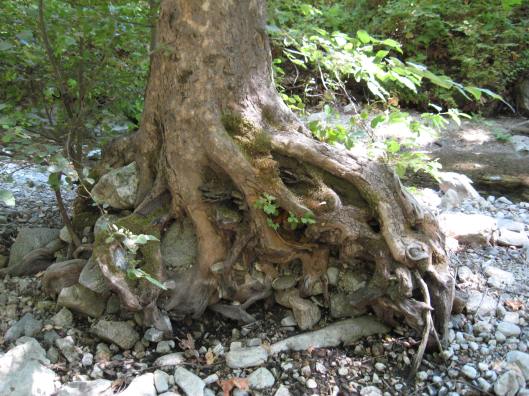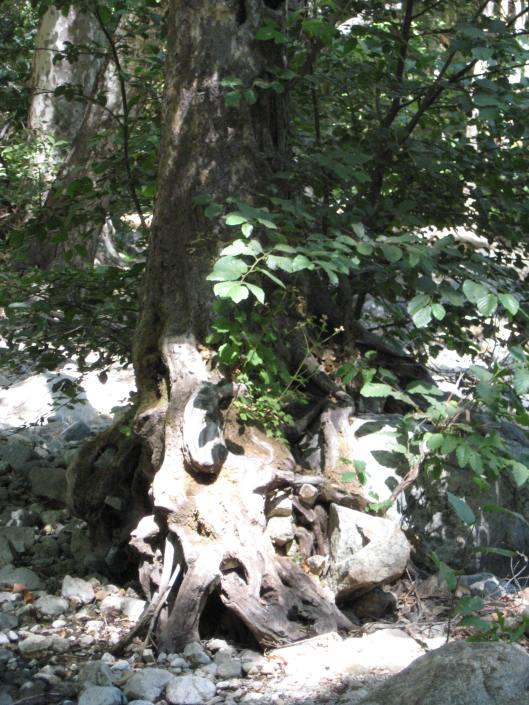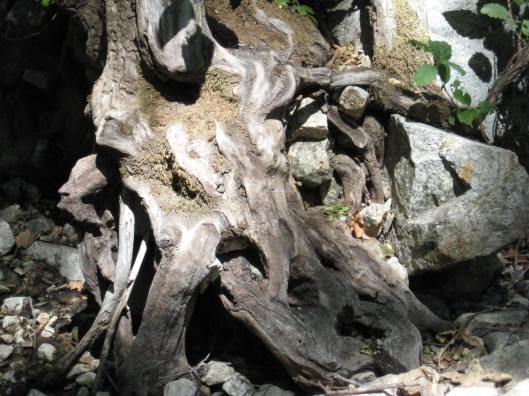Tags
Hermann Hesse, holiness, life, Nature, Philosophy, quote, trees

Recently a woman sent me a message on Facebook, commenting on my cover photo of the “glorious” tree roots intricately woven around rocks. She wondered where I found the photo. I told her I came upon the tree when hiking along a river in the mountains above Big Sur. Something about the tree and its rootedness arrested me, and inspired me so much I use it on several of my online sites. It’s gratifying that others are inspired by it as I have been. But trees have been an inspiration for artists and philosophers throughout the ages.
Recently I came across this quote from Hermann Hesse, the author of Siddhartha, on Zen Flash.
For me, trees have always been the most penetrating preachers. I revere them when they live in tribes and families, in forests and groves. And even more I revere them when they stand alone.
They are like lonely persons. Not like hermits who have stolen away out of some weakness, but like great, solitary men, like Beethoven and Nietzsche.
In their highest boughs the world rustles, their roots rest in infinity; but they do not lose themselves there, they struggle with all the force of their lives for one thing only: to fulfill themselves according to their own laws, to build up their own form, to represent themselves. Nothing is holier, nothing is more exemplary than a beautiful, strong tree…
Trees are sanctuaries. Whoever knows how to speak to them, whoever knows how to listen to them, can learn the truth. They do not preach learning and precepts, they preach, undeterred by particulars, the ancient law of life.”
~Hermann Hesse
The line I love most is how “they struggle with all the force of their lives for one thing only: to fulfill themselves according to their own laws, to build up their own form, to represent themselves.” And that is “exemplary” as Hesse notes and denotes a kind of holiness, to remind us all of the need to be true to ourselves, to find our singular purpose in being and struggle with all the force of our lives to fulfill it, regardless of whether anyone takes note of it or us at all.
That tree found growing along the bank of that creek may have gone unseen, unappreciated by human eyes, its entire lifespan, and yet it would have fulfilled its purpose nonetheless. That is its great strength, the thing that makes it exemplary, and holy. Simply being what one was meant to be suffices. Nothing else is needed.
Having said that, here’s a paradox: The tree cannot fulfill itself alone. It is dependent upon its entire environment to fulfill its purpose. Those stones that probably felt like such an obstacle when it was striving to grow from a sapling to a mighty oak is what helped shape it and distinguish it and perhaps even strengthen it. It is what drew me to the tree.
I found in it something almost indescribably beautiful and inspiring, how it used the very stones that blocked its roots to build a firm foundations, and how it in turn become the foundation of new growth, creating a home for the ivy and moss and lichens that grow upon it, giving shelter to the small animals and insects that burrow beneath. It exemplifies that interdependence by which we all live and shows how strength and vulnerability grow hand in hand to create beautiful lives.
Here are a few more faces of this lovely tree.





Other posts on trees you might like:

As you know I am passionate about trees and they show up in my paintings often. There is something that I just cannot resist about a good strong tree. Beautiful post Deborah!
Thank you, Terrill. I love your paintings of trees!
I’ve been thinking about trees, too, mostly because so many of our Ash trees have been blighted and killed by the Emerald Ash Borer beetle and the face our neighbourhood has been dramatically altered because of it. But I had never thought of the “holiness” of trees. This phrase “…to remind us all of the need to be true to ourselves, to find our singular purpose in being and struggle with all the force of our lives to fulfill it, regardless of whether anyone takes note of it or us at all” bears pondering. It has the potential to quieten the mind. Have you heard of “forest bathing”?
I’ve never heard of that phrase, but I love it and can well imagine what it might mean. I know that when I’m in a forest I often want to just sit and empty my mind of thought and let the sights and sounds and smells of the forest wash through me. Is that what you had in mind by the phrase too?
Forest bathing is an actual restorative practice from Japan that involves walking under a forest canopy which is supposed to help calm, rejuvenate, and restore you. Absolutely like letting the forest wash over you/through you. I know when I walk in the woods I always clear my head and generally feel calmer afterwards. The wonder of beautiful old trees, eh?
How interesting! I’ll have to read more about that practice. Being immersed in nature, whether the forest or seashore or mountaintop does have a rejuvenating effect. So glad you shared this with me.
Hello Deborah. Lovely article. I was taking pictures of trees this past weekend in the snow – as inspirations and models for some artwork I am doing. None came close to being as interesting as your tree. I agree that trees are holy and that they can be sanctuaries. It’s funny but I just finished finally reading Tolkien’s “The Two Towers”, the one in which the Ents or tree people are the heroes. Now that is some great tree literature!
Thank you, CJ. I loved the whole Tolkien trilogy and read it aloud to my kids and husband when we were sailing on our boat La Gitana.. The Game of Throne series also features some pretty amazing sacred tree.
Trees are my loves.
(Smile)
Deborah, your post is beautifully written and thought provoking. In fact, I read through it a few times to really embrace the message.
That tree truly did fulfill it’s purpose, didn’t it? The root structure is incredible!
Thank you, LB. That means a lot.
Love this! Just today I did my walk which is to go down to the park and make 9 circuits of a little botanic tree garden, the trees have plaques telling us about them and the age they can live to, I was alone in the little tree garden except for a teenage boy, who seemed to have stumbles across it for the first time, he asked my permission to be there, I said its for everyone and he was just astounded by the trees and took photos with them and I felt this great awe for them too, there was a mistral wind blowing and although few had leaves, they were communing with each other and preparing for spring, it was just great, so it is fabulous to read this post on a day that I personally connected with a lot of special trees that I normally just run past, and though I always appreciate them, today I was paying homage.
Synchronicity–is that what they call this? Your tree garden sounds delicious. I wish I could see it. How wonderful that you were there to witness that young man discovering the wonder of trees with you..